The easy way to do this is to use a 20m buffer around a line created from your points. So some code like this to create a line from the points (:
String[] wkt = {
"Point (-0.13666168754467312 50.81919869153657743)",
"Point (-0.13622277073931291 50.82205165077141373)",
"Point (-0.13545466632993253 50.82512406840893959)",
"Point (-0.13457683271921211 50.82687973563037787)",
"Point (-0.13413791591385191 50.82907431965718104)",
"Point (-0.13951464677951447 50.8294035072611976)",
"Point (-0.14346489802775639 50.83082998687861931)",
"Point (-0.14697623247063807 50.83072025767727808)",
"Point (-0.15004865010815954 50.83390240451614517)",
"Point (-0.15740050659794308 50.8349996965295432)",
"Point (-0.16486209228906662 50.83741373895902171)",
"Point (-0.17276259478555042 50.83894994777778464)",
"Point (-0.18549118214099652 50.8387304893751022)"
};
//build line
WKTReader2 reader = new WKTReader2();
GeometryFactory gf = new GeometryFactory();
Coordinate[] points = new Coordinate[wkt.length];
int i=0;
for(String w:wkt) {
Point p;
try {
p = (Point) reader.read(w);
points[i++]=p.getCoordinate();
} catch (ParseException e) {
// TODO Auto-generated catch block
e.printStackTrace();
}
}
LineString line = gf.createLineString(points);
SimpleFeatureBuilder builder = new SimpleFeatureBuilder(schema);
builder.set("locations", line);
SimpleFeature feature = builder.buildFeature("1");
And then a BufferLine method like:
public SimpleFeature bufferFeature(SimpleFeature feature, Measure<Double, Length> distance) {
// extract the geometry
GeometryAttribute gProp = feature.getDefaultGeometryProperty();
CoordinateReferenceSystem origCRS = gProp.getDescriptor().getCoordinateReferenceSystem();
Geometry geom = (Geometry) feature.getDefaultGeometry();
Geometry pGeom = geom;
MathTransform toTransform, fromTransform = null;
// reproject the geometry to a local projection
if (!(origCRS instanceof ProjectedCRS)) {
Point c = geom.getCentroid();
double x = c.getCoordinate().x;
double y = c.getCoordinate().y;
String code = "AUTO:42001," + x + "," + y;
// System.out.println(code);
CoordinateReferenceSystem auto;
try {
auto = CRS.decode(code);
toTransform = CRS.findMathTransform(DefaultGeographicCRS.WGS84, auto);
fromTransform = CRS.findMathTransform(auto, DefaultGeographicCRS.WGS84);
pGeom = JTS.transform(geom, toTransform);
} catch (MismatchedDimensionException | TransformException | FactoryException e) {
// TODO Auto-generated catch block
e.printStackTrace();
}
}
// buffer
Geometry out = buffer(pGeom, distance.doubleValue(SI.METER));
Geometry retGeom = out;
// reproject the geometry to the original projection
if (!(origCRS instanceof ProjectedCRS)) {
try {
retGeom = JTS.transform(out, fromTransform);
} catch (MismatchedDimensionException | TransformException e) {
// TODO Auto-generated catch block
e.printStackTrace();
}
}
// return a new feature containing the geom
SimpleFeatureType schema = feature.getFeatureType();
SimpleFeatureTypeBuilder ftBuilder = new SimpleFeatureTypeBuilder();
ftBuilder.setCRS(origCRS);
// ftBuilder.setDefaultGeometry("buffer");
ftBuilder.addAll(schema.getAttributeDescriptors());
ftBuilder.setName(schema.getName());
SimpleFeatureType nSchema = ftBuilder.buildFeatureType();
SimpleFeatureBuilder builder = new SimpleFeatureBuilder(nSchema);
List<Object> atts = feature.getAttributes();
for (int i = 0; i < atts.size(); i++) {
if (atts.get(i) instanceof Geometry) {
atts.set(i, retGeom);
}
}
SimpleFeature nFeature = builder.buildFeature(null, atts.toArray());
return nFeature;
}
/**
* create a buffer around the geometry, assumes the geometry is in the same
* units as the distance variable.
*
* @param geom
* a projected geometry.
* @param dist
* a distance for the buffer in the same units as the projection.
* @return
*/
private Geometry buffer(Geometry geom, double dist) {
Geometry buffer = geom.buffer(dist);
return buffer;
}
The tricky part is reprojecting into a locally flat CRS so that you can use metres for the buffer size. If you know of a locally good projection you could just use that (in this case we could have used OSGB (EPSG:27700) for better results).
This gives the following map:

